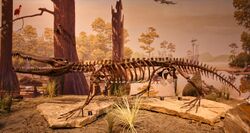Biology:Borealosuchus
| Borealosuchus | |
|---|---|

| |
| Skeleton cast at the North Dakota Heritage Center & State Museum | |
| Scientific classification | |
| Missing taxonomy template (fix): | Archosauria/Reptilia |
| Clade: | Pseudosuchia |
| Clade: | Crocodylomorpha |
| Clade: | Crocodyliformes |
| Clade: | Eusuchia |
| Genus: | †Borealosuchus Brochu, 1997 |
| Species | |
| |
Borealosuchus (meaning "boreal crocodile") is an extinct genus of crocodyliforms that lived from the Late Cretaceous to the Eocene in North America. It was named by Christopher Brochu in 1997 for several species that had been assigned to Leidyosuchus. The species assigned to it are: B. sternbergii, the type species, from the Maastrichtian (Late Cretaceous) of Colorado, Montana, North Dakota, South Dakota, and Wyoming; B. acutidentatus, from the Paleocene of Saskatchewan; B. formidabilis, from the Paleocene of North Dakota;[2] B. griffithi, from the Paleocene of Alberta;[3] and B. wilsoni, from the Eocene of Wyoming.[2] B. formidabilis is particularly well-known, represented by the remains of many individuals from the Wannagan Creek site in North Dakota.[4]
Borealosuchus was a mid-sized crocodyliform, with B. wilsoni measuring approximately 3.2–4.5 metres (10–15 ft) long.[5]
Taxonomy
Six species of Borealosuchus are currently recognized. In order of their naming, they are B. sternbergii, B. acutidentatus, B. wilsoni, B. formidabilis, B. griffithi, and B. threeensis.[6] Four of these species (B. sternbergi, B. acutidentatus, B. wilsoni, and B. formidabilis) were originally named as species of Leidyosuchus.
A sixth species of Borealosuchus, B. threeensis, was named in 2012. Fossils of this species were found in the Inversand Company Marl Pit of Gloucester County, New Jersey. The specific name is a reference to Exit 3 of the New Jersey Turnpike, which is the closest highway exit to the type locality. The authors of the paper describing B. threeensis noted that the name is "in reference to a question every New Jersey resident encounters when traveling: 'Oh, you're from New Jersey? Which exit?'".[7]
Classification
Although some earlier phylogenetic studies proposed Borealosuchus to be a member of Crocodylia,[7][8] recent studies are now recovering Borealosuchus as a basal eusuchian not belonging to Crocodylia,[9][10][1] as shown in the cladogram below:[1]
| Eusuchia |
| ||||||||||||||||||||||||||||||||||||||||||||||||||||||||||||||||||||||||||||||||||||||||||
References
- ↑ Jump up to: 1.0 1.1 1.2 Rio, Jonathan P.; Mannion, Philip D. (6 September 2021). "Phylogenetic analysis of a new morphological dataset elucidates the evolutionary history of Crocodylia and resolves the long-standing gharial problem". PeerJ 9: e12094. doi:10.7717/peerj.12094. PMID 34567843.
- ↑ Jump up to: 2.0 2.1 Brochu, C.A. (1997). "A review of "Leidyosuchus" (Crocodyliformes, Eusuchia) from the Cretaceous through Eocene of North America". Journal of Vertebrate Paleontology 17 (4): 679–697. doi:10.1080/02724634.1997.10011017.
- ↑ Wu, X-C.; Brinkman, D.B.; Fox, R.C. (2001). "A new crocodylian (Archosauria) from the basal Paleocene of the Red Deer River Valley, southern Alberta". Canadian Journal of Earth Sciences 38 (12): 1689–1704. doi:10.1139/cjes-38-12-1689.
- ↑ Erickson, Bruce R. (1976). Osteology of the Early Eusuchian Crocodile Leidyosuchus formidabilis, sp. nov. The Science Museum of Minnesota St. Paul, Minnesota Monograph 2, Paleontology. St. Paul: The Science Museum of Minnesota. pp. 1–61.
- ↑ Iijima, M.; Kubo, T. (2020). "Vertebrae-Based Body Length Estimation in Crocodylians and Its Implication for Sexual Maturity and the Maximum Sizes". Integrative Organismal Biology 2 (1): obaa042. doi:10.1093/iob/obaa042.
- ↑ [1] Fossilworks
- ↑ Jump up to: 7.0 7.1 Brochu, C.A.; Parris, D.C.; Grandstaff, B.S.; Denton, R.K. Jr.; Gallagher, W.B. (2012). "A new species of Borealosuchus (Crocodyliformes, Eusuchia) from the Late Cretaceous–early Paleogene of New Jersey". Journal of Vertebrate Paleontology 32 (1): 105–116. doi:10.1080/02724634.2012.633585.
- ↑ Eduardo Puértolas; José I. Canudo; Penélope Cruzado-Caballero (2011). "A New Crocodylian from the Late Maastrichtian of Spain: Implications for the Initial Radiation of Crocodyloids". PLOS ONE 6 (6): e20011. doi:10.1371/journal.pone.0020011. PMID 21687705. Bibcode: 2011PLoSO...620011P.
- ↑ Diego Pol; Alan H. Turner; Mark A. Norell (2009). "Morphology of the late Cretaceous crocodylomorph Shamosuchus djadochtaensis and a discussion of neosuchian phylogeny as related to the origin of Eusuchia". Bulletin of the American Museum of Natural History 324: 1–103.
- ↑ Michael S. Y. Lee; Adam M. Yates (27 June 2018). "Tip-dating and homoplasy: reconciling the shallow molecular divergences of modern gharials with their long fossil". Proceedings of the Royal Society B 285 (1881). doi:10.1098/rspb.2018.1071. PMID 30051855.
External links
Wikidata ☰ Q2489118 entry
 |




